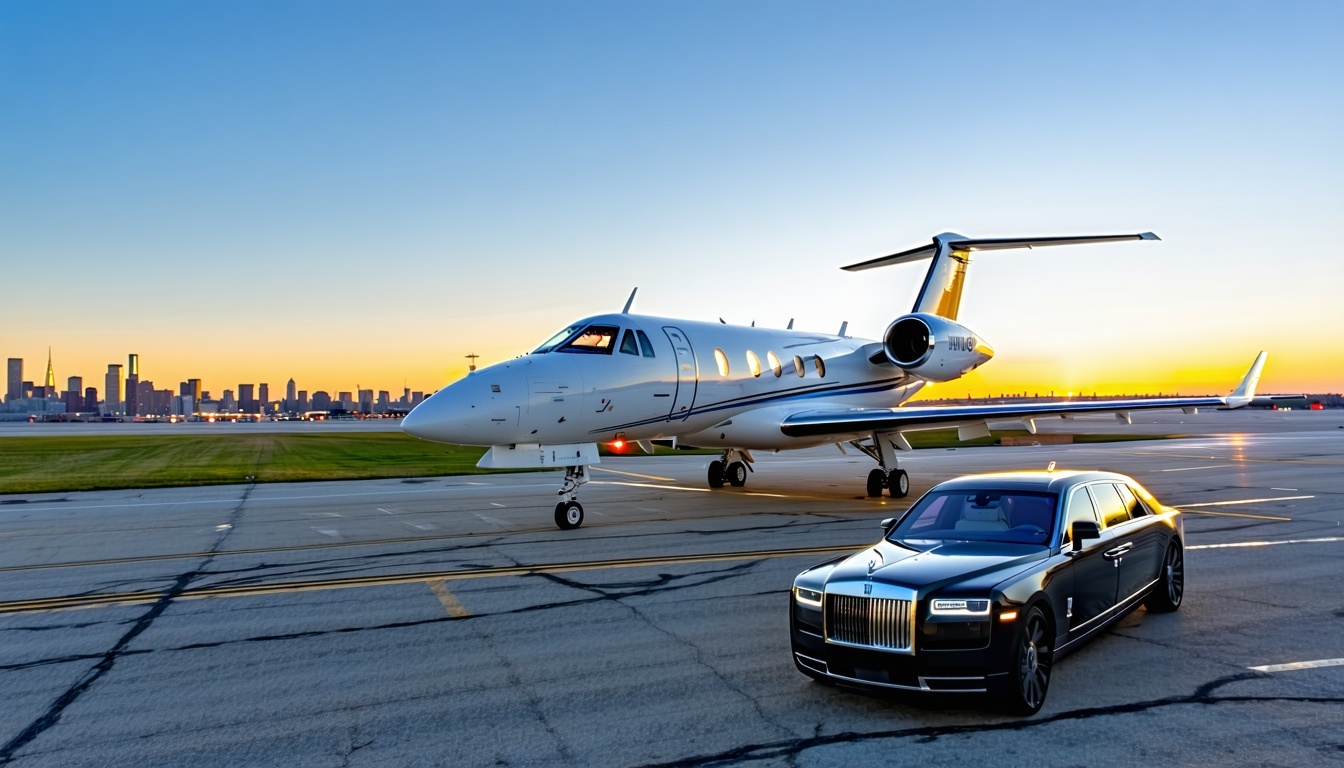4 min read
Private Jet Classifications: Light Jets to Ultra-Long-Range Aircraft
Insights Team
:
Jul 2, 2025 8:40:12 AM
.jpg)
In the exclusive world of private aviation, aircraft classifications determine everything from cabin space and passenger capacity to flight range and airport accessibility. Whether you're considering charter options, fractional ownership, or outright purchase of a private jet, understanding these classifications is essential for making informed decisions about luxury air travel.
The Private Jet Spectrum: From Light to Ultra-Long-Range
Private jets are categorized based on size, range, and capabilities, creating a hierarchy that serves different travel needs and budgets. Let's explore each classification in detail.
Light Jets: Entry-Level Luxury
Light jets represent the entry point into true private jet ownership and charter. These nimble aircraft deliver impressive performance while maintaining cost efficiency.
Key Characteristics of Light Jets:
- Cabin Size: Typically 55-58 inches in height with 5-6 passenger capacity
- Range: 1,000-1,800 nautical miles (approximately 2-3 hours of flight time)
- Cruising Speed: 400-480 knots
- Runway Requirements: Can access smaller regional airports with runways as short as 3,000 feet
- Operating Costs: Lower hourly operating costs compared to larger aircraft
- Popular Models: Cessna Citation CJ series, Embraer Phenom 100, HondaJet
Ideal Use Cases:
Light jets excel at short hops between regional business centers, making them perfect for executives needing to visit multiple locations in a single day. Their ability to access smaller airports brings passengers closer to their final destinations.
Super Light Jets: Enhanced Capability
Super light jets (sometimes called light-medium jets) bridge the gap between light and midsize categories, offering slightly more space and range.
Key Characteristics of Super Light Jets:
- Cabin Size: Approximately 5 feet in height with 6-8 passenger capacity
- Range: 1,800-2,500 nautical miles
- Cruising Speed: 430-480 knots
- Baggage Capacity: Enhanced compared to light jets
- Popular Models: Cessna Citation XLS+, Learjet 75, Embraer Phenom 300
Ideal Use Cases:
These aircraft serve transcontinental flights within the United States while maintaining excellent short-field performance. They're ideal for business travelers who need slightly more space but still value efficiency.
Midsize Jets: The Versatile Middle Ground
Midsize private jets offer a significant step up in comfort and capability while maintaining reasonable operating costs.
Key Characteristics of Midsize Jets:
- Cabin Size: Approximately 5.7-5.9 feet in height with 7-9 passenger capacity
- Range: 2,000-3,000 nautical miles (4-5 hours of flight time)
- Cruising Speed: 430-480 knots
- Cabin Amenities: Full stand-up cabins, enclosed lavatories, enhanced galley facilities
- Popular Models: Cessna Citation Latitude, Bombardier Challenger 350, Gulfstream G280
Ideal Use Cases:
Midsize jets handle coast-to-coast flights in the United States and can connect many city pairs across Europe. They offer an excellent balance between comfort and cost for medium-range business travel.
Super Midsize Jets: Transcontinental Comfort
Super midsize jets deliver near-heavy jet capabilities with better economics and more airport flexibility.
Key Characteristics of Super Midsize Jets:
- Cabin Size: 6+ feet in height with 8-12 passenger capacity
- Range: 3,000-4,000 nautical miles (5-7 hours of flight time)
- Cruising Speed: 470-530 knots
- Cabin Amenities: Full stand-up cabins, dedicated sleeping areas, enhanced entertainment systems
- Popular Models: Bombardier Challenger 650, Gulfstream G280, Cessna Citation Longitude, Embraer Praetor 600
Ideal Use Cases:
These aircraft excel at transcontinental flights with full passenger loads and can handle some transatlantic routes, making them versatile options for businesses with diverse travel needs.
Heavy Jets: Global Business Tools
Heavy jets (sometimes called large-cabin jets) represent a significant leap in capabilities, offering true global reach.
Key Characteristics of Heavy Jets:
- Cabin Size: 6+ feet in height with 10-16 passenger capacity
- Range: 4,000-5,000 nautical miles (7-8 hours of flight time)
- Cruising Speed: 470-530 knots
- Cabin Configuration: Multiple distinct cabin zones, full galleys, private sleeping quarters
- Popular Models: Gulfstream G450/G500, Bombardier Challenger 850, Dassault Falcon 900LX
Ideal Use Cases:
Heavy jets handle intercontinental flights with ease, connecting major global business centers like New York to London or Los Angeles to Tokyo, making them essential tools for international corporations.
Ultra-Long-Range Jets: The Ultimate in Private Aviation
Ultra-long-range jets represent the pinnacle of private aviation, offering unmatched range, space, and luxury.
Key Characteristics of Ultra-Long-Range Jets:
- Cabin Size: 6-8 feet in height with 12-19 passenger capacity
- Range: 5,000-7,500+ nautical miles (10-15 hours of flight time)
- Cruising Speed: 490-560 knots
- Cabin Amenities: Multiple cabin zones, master bedrooms, shower facilities, conference rooms
- Popular Models: Bombardier Global 7500, Gulfstream G650ER/G700, Dassault Falcon 10X
Ideal Use Cases:
These flagship aircraft can connect virtually any two cities on Earth with a single stop or none at all. They're designed for high-net-worth individuals, heads of state, and global corporations requiring the ultimate in range and comfort.
VIP Airliners: Beyond Traditional Private Jets
For the most demanding requirements, VIP conversions of commercial airliners offer unmatched space.
Key Characteristics of VIP Airliners:
- Cabin Size: Massive customizable interiors with 20-50+ passenger capacity
- Range: Varies by model, typically 5,000-8,000 nautical miles
- Cabin Amenities: Multiple bedrooms, dining rooms, offices, entertainment areas
- Popular Models: Boeing Business Jet (BBJ) series, Airbus Corporate Jets (ACJ)
Ideal Use Cases:
These aircraft serve heads of state, royal families, and ultra-high-net-worth individuals requiring mobile residences rather than simple transportation.
Choosing the Right Classification for Your Needs
When selecting a private jet classification, consider these key factors:
- Typical Flight Distance: Match your common routes with appropriate aircraft range
- Passenger Count: Ensure comfortable accommodation for your typical party size
- Airport Accessibility: Consider runway requirements if using smaller airports
- Budget Considerations: Balance acquisition and operating costs with capabilities
- Amenity Requirements: Determine which cabin features are essential for your travel style
The Future of Private Jet Classifications
The private aviation industry continues to evolve, with manufacturers pushing the boundaries of each classification:
- Sustainable Aviation: New eco-friendly options emerging across all categories
- Enhanced Efficiency: Next-generation aircraft offering better range and lower operating costs
- Technology Integration: Advanced connectivity and cabin management systems becoming standard
- Supersonic Revival: Potential new ultra-fast category with aircraft like the in-development Aerion AS2
Conclusion
Understanding private jet classifications is essential for making informed decisions in the world of luxury aviation. From light jets offering efficient regional travel to ultra-long-range aircraft connecting any two points on the globe, each category serves specific needs and represents different levels of investment.
Whether you're exploring charter options, considering fractional ownership, or evaluating an outright purchase, matching your requirements to the appropriate aircraft classification ensures you'll enjoy the perfect balance of capability, comfort, and cost in your private aviation experience.
For more information or to get a free, fast, no obligation quote on flying private for your next trip, visit us at luxuryaircraftsolutions.com

.png)

.jpg)
